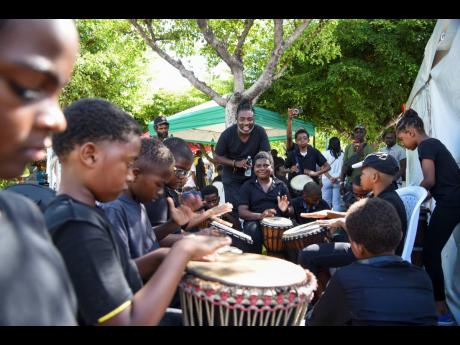Dennis Minott | Jamaica’s education system could more build minds, not just buildings
As Jamaica approaches the start of a new school year in September, the focus on rebuilding schools damaged by Hurricane Beryl highlights a recurring challenge in the nation’s education system. While infrastructure improvements are necessary, they often overshadow the critical need for comprehensive education policy reform.
INFRASTRUCTURE TRAP
The cyclical nature of this issue is evident in political slogans like ‘Goat Island Schools: Built by Labour, Rebuilt by Comrades’. This pattern of successive administrations prioritising visible improvements to school buildings over less tangible but equally crucial aspects of educational policy has become a hallmark of Jamaica’s approach to education. However, this emphasis on physical reconstruction comes at a cost. As authorities focus on restoring damaged facilities, education guidance and policy development are often relegated to low priority status. The consequences of this imbalanced approach are reflected in the disappointing outcomes of high-school examinations like CSEC and CAPE, suggesting that improved buildings alone are insufficient to ensure quality education and student performance.
BEYOND BRICKS AND MORTAR
To transform Jamaica’s education system, a more holistic approach is needed. This should include:
– Curriculum reform aligned with global standards and local needs
– Enhanced teacher training and professional development programmes
– Implementation of innovative teaching methodologies
– Integration of technology in education
– Development of robust assessment and feedback systems
– Strategies to address socio-economic factors affecting student performance
– Visionary leaders
It’s worth noting that several past leaders have understood and grasped the importance of comprehensive education reform. Edwin Allen, Burchell Whiteman, Omar Davies, Edward Seaga, Neville Gallimore, Ronald Thwaites, Peter Phillips, and P.J. Patterson demonstrated a keen understanding of the need to prioritise education policy alongside infrastructure development.
MISSION OF EDUCATION MINISTER
The role of an education minister extends far beyond overseeing the construction and maintenance of school buildings. Their mission should encompass:
– Developing comprehensive education policies
– Addressing curriculum development and implementation
– Improving teacher training and support
– Enhancing assessment methods
– Ensuring equitable access to quality education.
BREAKING THE CYCLE
As Jamaica faces the dual challenges of post-hurricane reconstruction and the start of a new school year, now is the time to break this cycle. The nation must place equal emphasis on both the physical and intellectual aspects of education. This requires a paradigm shift from focusing mainly on buildings to building minds.
By prioritising comprehensive education policy reform alongside infrastructure development, Jamaica can hope to see significant improvements in educational outcomes. This balanced approach will better prepare students for the challenges of the 21st century and contribute to the nation’s overall development. The future of Jamaica’s youth depends not just on the strength of their school buildings, but on the strength of the education system as a whole. It’s time for Jamaica to invest in building minds, not just buildings, and create an education system that empowers citizens and drives national progress.
Stay on mission, Chief Education Officer. Stay on mission, Permanent Secretary. Stay on mission, compassionate Minister!
What are some successful examples of countries that have prioritised education policy over infrastructure?
SHOWING RATHER THAN TELLING
Several countries have successfully prioritised education policy and reform over simply focusing on infrastructure, with notable results:
– Finland stands out as a prime example of prioritising comprehensive education policy reform. Since the 1970s, Finland has taken a holistic approach focused on equity, teacher quality, and student well-being, rather than just buildings or technology. Key elements of Finland’s success include:
– Getting the right people to become teachers through selective admissions to teacher education programmes
– Developing teachers into effective instructors through high-quality preparation and support
– Ensuring every student receives excellent instruction by focusing on equity across schools
– Despite spending less per student than the US average, Finland has achieved top rankings on international assessments like PISA, with remarkably low variability in performance across schools.
China has also made significant strides through policy reforms since the early 2000s, transforming its education system through a focus on:
– Equality and access to education for all citizens
– Improving quality and productivity of education
– Enhancing efficiency as a national priority
– Using education to support national development and global competitiveness.
China implemented reforms across basic education, teacher education, and higher education simultaneously. This comprehensive policy approach helped China rapidly improve its education system.
Estonia provides another example of prioritising policy over infrastructure alone. Estonia has taken a unitary approach with one national body responsible for education policy and services throughout early childhood and primary education. This unified governance has allowed for more coherent policymaking and implementation.
Some key lessons from these examples include:
– Taking a holistic, system-wide approach to education reform rather than piecemeal changes
– Focusing on teacher quality and support as a core driver of educational improvement
– Ensuring equity and access across all schools and regions
– Aligning education policy with broader national development goals
– Creating coherent governance structures to develop and implement reforms.
While infrastructure remains important, these countries demonstrate how prioritising comprehensive policy reform can lead to significant educational improvements, even without massive infrastructure investments. The focus is on making the most effective use of existing resources through smart policies and practices.
The populations of Finland, China, Estonia, Bhutan, and Costa Rica, respectively, are as follows:
Finland: Approximately 5.5 million
China: Approximately 1.4 billion
Estonia: Approximately 1.3 million
Bhutan: Approximately 800,000
Costa Rica: Approximately 5.2 million
Stay on mission, compassionate officials! To the mission, National Works Agency, plus.
Dennis Minott, PhD, is the CEO of A-QuEST-FAIR. He is a multilingual green resources specialist, a research physicist, and a modest mathematician who worked in the oil and energy sector. Send feedback to a_quest57@yahoo.com or columns@gleanerjm.com.


